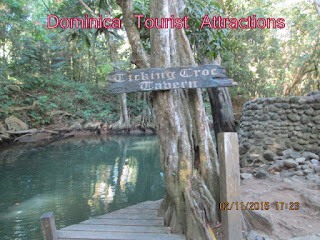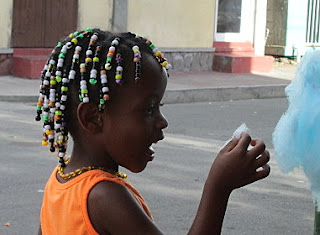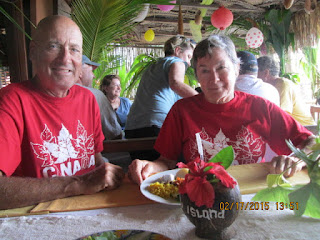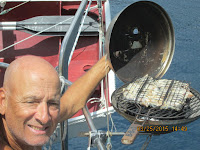Time passes and we move a bit slower but we know some of you have asked "where is the blog"? We have decided to provide more photos and less verbiage. We are about to embark on another cruising season to our favourite places!
GRENADA
We
arrived in Grenada on December 1 to prepare our S/V “Charlotte D”
for another winter of cruising the SE Caribbean.
The
day of returning the “Charlotte D” to the water is always a
happy, but stressful, day. We took several days to recuperate at
anchor in Prickly Bay, enjoying daily swims in the bay and in the
fresh water pool at the St. George University Club.
For
comfortable and safe sailing, accurate weather forecasts are
critical. Fortunately, there are numerous sources of weather
forecasts. We start our day with the 0600 “net” operated by
Chris Parker on HF radio. After that Denis, a retired weatherman and
fellow Canadian from S/V “Tiger Lily II”, provides updates and
interpretation on his “net” at 0745. We also use HF radio to
obtain NOAA forecasts and GRIB (Gridded
Binary Data) files based on the GFS model (Global Forecast System).
Many internet sites provide forecasts and we use these when internet
is available. Internet weather sources at
http://accidentalcruiser.com/features/internetWeather.html
As usual, there was a long list of projects. These were mostly routine re-commissioning and maintenance, but also repairs and upgrades. In the repair category were installing the rebuilt starter motor for our Perkins engine, renewing fittings of the chain-plate for inner fore-stay, and replacing the control cable of engine throttle. Catherine got her iPad screen replaced in St. George with satisfying results. It was done promptly and economically.
We enjoyed the local cuisine at Patrick's with friends.
The upgrade category included two new sails.
We enjoy many aspects of Prickly Bay, renewing cruising acquaintances and making new ones. Prickly Bay Marina is now the venue for daily exercise and social activities such as Tai Chi, yoga, chess, dominoes, trivial pursuit and movies. Happy Hour beers and gin and tonics are enjoyable, especially on Friday nights when pizza is 2-for-1!
There was the Cruisers' Christmas Beach BBQ. The potluck dishes provided by the cruisers and the grilled lobster were wonderful. Catherine joined the crew of S/V “Sea Bear” to play a few tunes on the beach.
We decided to delay our Grenada departure until abatement of Christmas winds and associated large seas. We finally left heading for Tyrrel Bay, Carriacou (part of Grenada).
Tyrrel Bay is a protected anchorage where we sheltered during a period of strong winds. Duty-free diesel fuel was available. We had the pleasure of getting better acquainted with the crew of S/V “Moody Blues”, whose Susea McGearhart is author of two interesting sailing books. The first, “Red Sky in Mourning”, is an amazing true story of the survival of a young woman who, after the loss of her husband at sea during a Pacific Ocean hurricane, brought their dis-masted sailboat to port. The second recounts “Moody Blues” adventurous sailing, “Unfurling the Heart”. We thank her for loaning us these two books.
Before leaving Carriacou, we spent a couple of days relaxing at the anchorage of Sandy Island, part of a marine preserve. The beach is beautiful, but not easy to access by dinghy due to rocky approach and surf. Catherine was able to do a little "hooking".
*********************************************************************************
MARTINIQUE
We sailed overnight to Martinique with a sky full of stars which were identified with the iPad app “Skywalk". As usual, we alternated three hour watches around the clock. Arriving just before dawn at Sainte-Anne, Martinique, we had a welcome nap before going into Le Cul-de-Sac Marin to clear with French Customs and Immigration. This is also a wonderful place for re-provisioning. We are particularly attracted to the offerings of spices, fresh produce, baguettes, French wine and local rum.
We returned after our shop and customs to Sainte-Anne where we had more adventures: magnificent hikes, swimming, dining, and lounging on the beach, while awaiting our visitors from Florida.
Hiking is best in the early part of the day. We like the trail going sound from the village of Ste-Anne for magnificent views of Diamond Rock and St. Lucia (25 miles to the south), a variety of forests (ranging from wetland to upland), a salt pond, remnants of military forts, even a small chapel.
When we hike this trail, we usually stop for lunch at Creola Beach Restaurant after cooling at their wading beach. We are often pleased to encounter cruising friends there.
Conveniently, BouBou's cafe in Sainte-Anne has recently been authorized as a site for clearing Customs and Immigration. While there for clearance and bokit sandwich we are entertained by the passing students wishing us "Bonjour and Bon Appetite". We are impressed with how polite these students are, looking sharp in well-fitting uniforms of jeans and tucked in white shirts. Looking sharp. There were no holes in their clean jeans. There were no short skirts, cut-offs or underwear showing.
We chanced to be in Le Cul-de-Sac Marin during a Yole Regatta. We had optimum seats in our cockpit while numerous colorful yoles were winding their way around anchored boats, deftly steering and trimming. Click on this video to view a pass to our transom.
We met our visitors at the airport and drove to Fort-de-France for a night at Hotel L' Imperatrice, a once-elegant-now-somewhat-worn hotel located downtown adjacent to La Savane.
The park is bordered with “cabanas” offering various gastronomic delights. We enjoyed a dinner outside at Bernadette's cabana. At the adjacent table was a group of gentlemen elegantly dressed in white, including white Panama hats. We wandered around later enjoying the Old Fort in the background and the sailboats anchored in the harbour. We discovered a crowd surrounding a stage. We noticed the gentlemen from Bernadette's cabana among others performing the local Quadrille Dance, following the caller, similar to square dancing. A surprise ending to the evening.
For a sample of this dancing scene click on the video.
For more information about the Quadrille dance click this link http://www.caribbeancommunities.eu/quadrille_in_the_caribbean.html
The next morning we drove the coastal route to Saint-Pierre and the Centre de Découverte des Sciences et de la Terre which was so well-described by our friends aboard S/V “Cat Tales”. There is a terrific documentary film, “Volcans des Antilles”, which recounts Mt. Pelée’s eruption and the destruction of the city of St. Pierre in 1902. This is still an active volcano. Other volcanoes in the island chain of the SE Caribbean are known for their volcanic activity, including Saint Vincent's La Soufrière, Guadeloupe's La Grande Soufriere, Montserrat's Soufrière Hills, and the submarine volcano Kick 'em Jenny. For more information http://en.wikipedia.org/wiki/Mount_Pel%C3%A9e
This is one of the most interesting museums in the Caribbean. English audio-guides and a fascinating film with English subtitles are included in the entrance fee of 3 Euro. We learned about volcanoes and the 1902 eruption of Mt Pelee which killed 30,000 people within minutes in the "Pearl of Martinique", as St. Pierre was once known.
This is one of the most interesting museums in the Caribbean. English audio-guides and a fascinating film with English subtitles are included in the entrance fee of 3 Euro. We learned about volcanoes and the 1902 eruption of Mt Pelee which killed 30,000 people within minutes in the "Pearl of Martinique", as St. Pierre was once known.
A visit to the Depaz Distillery followed a lovely lunch at the Moulin a Cannes. The
manager promised to have my favorite Coquelle St. Jacques ready for our next visit.
We took a lovely route home through the rain forest. between towering mountain peaks. Much of Martinique's interior is National park with trails to suit every hiker! Back in Sainte-Anne we returned our rental car after paying 7 Euro for 10 liters of diesel fuel. We spent a glorious next day on the beach where Peggy and Catherine met Veronique who had lovely Italian Maillots (tank suit), pareo (beach cover-up) and beach tunics that we thought looked quite nice on us.
aerobics class with swim noodles, bocce ball, hammock trees, swim lessons. We never miss the homemade ice cream (in many flavours: coffee, passion fruit, goyave, coco, rum raisin) when it is brought down the beach by wheelbarrow.
A must: checking the anchor to make sure it is buried deep in the sand.
***************************************************************************
DOMINICA
Underway to Dominica we passed Mt. Pelee volcano (1397 m) with not a cloud around it's peak (an usual event). It was a perfect time to play the fiddle. It was a glorious beam reach, on a perfect day. Our new mizzen and main sails performed well.
We arrived in Roseau from Martinique on Feb 10th and secured a mooring with Desmond of
SeaCat Yacht Services. There are lots of interesting things to see near Roseau but we will have
to return another day. We left early the next morning toward Prince Rupert Bay, Portsmouth.
We were greeted off shore by Titus of "Lawrence of Arabia" who welcomed us to
Dominica, introduced himself and said he would be at our service. Titus is member of PAYS, and employed by Lawrence of Arabia. We decided to go for an Indian River Cruise.
We were greeted off shore by Titus of "Lawrence of Arabia" who welcomed us to
Dominica, introduced himself and said he would be at our service. Titus is member of PAYS, and employed by Lawrence of Arabia. We decided to go for an Indian River Cruise.
Lawrence gave us the tour, with 34 years of experience along with another three cruisers from Austria. Check out this video.
The river narrows and is overhung with swamp bloodwood trees. Their massive buttress
roots spread out into the water and above the soil twisting into interesting designs.
Lawrence pointed out many botanical, fish and bird wonders as well
as scene sets from the movie "Pirates of the Caribbean". Long vines, crabs, herons, blue-headed
hummingbirds, forest. thrush, shrimp, ducks and fish abound. We stopped at a peaceful
Dominica is known as the "Nature Isle". It has the richest biodiversity in the Lesser Antilles, with 5 volcanoes, 50 fumaroles, hot sulfur springs, fresh water lakes, 11 waterfalls and a boiling lake. The lush vegetation, awe-inspiring mountains and waterfalls, birds, butterflies, brightly colored flowers are magical. The rainbows are phenomenal. See this video.
We enjoyed the small historical museum and strolling around the various renovated buildings of Ft. Shirley, a British fort dating from the 18th century which has been partially restored thanks in large part to Dr. Lennox Honeycutt, Dominican historian. He has written several publications, some which are on sale at the museum (The Dominica story). The Fort never fired a cannon shot in battle, but it was a booming garrison during the French and English Battle of the Saintes. It was abandoned in 1854.
One thing we know for certain, the weather always changes and so with the prediction of a
North swell, we moved to a mooring thinking the hook of land around the Cabrits might afford better protection.
The next morning we went to shore for a early hike on the East Cabrit where we enjoyed
the Commandant's Quarters, and the ruins of several barracks, cisterns and batteries (some
with canons still standing, others with parts of their canon supports resting high on the top of the mountain overlooking the Bay. We enjoyed tiny yellow orchids growing on tree trunks.
The views from the top were wonderful.
The views from the top were wonderful.
Answer:
"Because they're so small" Laurie Corbett
"Because they're so small" Laurie Corbett
quarters which is used for events. There are batteries, gun powder rooms, cisterns, kitchen, garrison barracks and stable. Informative signs identify some of the lovely trees on fort grounds.
The Cabrits National Park is a protected haven of forest., marsh and beaches formed by
the twin peaks of an extinct volcano. It includes the Cabrits Marine Park with some of the most.
wonderful snorkeling and diving. There is no anchoring but moorings have been placed for
dinghy use. In creating this park, the government was attempting to not only conserve the reefs
but provide employment for Dominicans as guides and small boat operators.
Hiking in Dominica can mean anything from a walk in the park, to a mountain ascent, to a swim
through a narrow gorge.
Feb 16th and 17th were Carnival Days and the Dominicans enjoy with great zest. We sat on
the sidewalk and watched some of the parade participants. The music is played on trucks with
huge speakers all night. The carnival here is spontaneous and friendly. Sensay costume has
returned to the streets (layers of banana leaves or strips of cloth often worn with a scary mask
usually with horns and platform clogs or boots). There is a lot of street dancing and no shortage
of beer, rum and ??
There are people from many countries in Dominica who have made successful homes and businesses.
We were treated by Patti of S/V Tevai and Gabrielle of S/V Cool Change, two Yoga Instructors. We and 10 fellow cruisers assembled ashore for yoga. It was wonderfully relaxing while listening to
Patti's soothing voice and the waves on the beach. It was Peter's first. experience with yoga
and Catherine's second, so we had a steep learning curve and our yoga senseis had keen
students. We greatly appreciated these ladies giving their time and patience to backs that refused to bend in the suggested stance.
Dominica is a friendly and cheerful place, but for years it was considered unsafe for cruisers. Recently, security has improved. For example, the local “boat boys” of Prince Rupert Bay, Portsmouth, have formed the Portsmouth Association of Yacht Security (PAYS). They have worked hard to improve the security situation in this bay. Each PAYS member must meet training requirements to be licensed.
Feb 15th was the PAYS Sunday BBQ. The BBQ is one way that security is paid
for in the anchorage. The BBQ offers grilled fish or chicken, rice and vegetables, salad, all the
rum punch, juice and food desired, and a DJ for dancers to enjoy all night.
Dominica is the breadbasket for many of the surrounding islands. Here are a few pics of the island bounty.
We were treated to a demonstration of coconut botany by Mr. Nice. We learned how to make coconut milk, cream and oil. Coconut oil can be used for hundreds of things. Kenroy had pointed out how coconuts are harvested earlier. For more click http://en.wikipedia.org/wiki/Copra
We joined six other cruisers for an island tour with Kenroy which included many lovely views, a visit to the Kalanaga Carib Reserve, a
splendid lunch at the Isle View, and a walk to Spanny Falls. Kenroy taught us a lot about the flora and fauna. We stopped at beautiful overlooks.
We stopped at the Kalinago Territory, a collectively owned 3,700 acre territory encompassing 8 hamlets on the north-eastern coast. of Dominica. Pure Caribs are Native Americans, bronze complected with Asian features. For more information see: www.kalinagoTerritory.com
We had a delightful lunch at Islet View in Castle Bruce while Peter enjoyed the local beer, Kubuli. Catherine had a local juice sipped with a straw from a coconut shell adorned with a hibiscus flower and aromatic bay leaves.
The Dominica Forestry Department has laid out many hiking trails. The Waitukubuli National Trail (WNT) is the only long distance (115 mile) hiking trail in the Caribbean. It was constructed in 2011 and an Eco-tourism site since 2013. It consists of old slave routes, traditional tracks and new tracks into Dominica's virgin forests. It showcases beautiful landscapes, countless river crossings, streams, historic sites, old ruins and evidence of the resilience and livelihoods of Dominicans. We walked only small bits of it. For more go to: www.waitukubulitrail.com.
On Sunday we once again joined Kenroy for a rainforest. wall and hike to Syndicate Falls. There
are two indigenous parrots in Dominica: the imperial or sisserou, the national bird; and the rednecked or Jacquot (sometimes spelled Jacobs).
The Syndicate Nature Trail is extremely well maintained with bridges made of 2 x 12 inch
hardwood. Kenroy knew his trees pointing out parasites, epiphytes, teak, mahogany, prop and
buttress roots, bromeliads. He explained that the heart of Dominica is lodged between the two
largest. volcanic massifs: Morne Trous Pitons and Morne Diablotin, named for the Black Capped
Petrels that once inhabited its slopes. Hundreds of st.reams carved their way through the
volcanic rock hundreds of years ago, creating deep River gorges and dozens of waterfalls. Here
the water is pure Spring water.
For reasons not clear to us, Uncle Sam chose to move the taxi onto a part of the Waitukubuli trail where it was promptly stuck in the mud, “on the slippery slope”. We were the only ones on this trail and out of cell phone range near the Syndicate Forest.. We spent two hours ineffectively trying to move the vehicle, only to become more and more imbedded in mud. We were impressed with the willingness of locals to assist.. One helper was a medic and hiking guide leading a group up the trail to Morne Trois Pitons. Finally, a family in a pickup truck with shovel and pick happened along collecting topsoil, and after changing a ruined tire, we extracted ourselves. It was more adventure than we had contracted for.
This inner part of the country was the heart of "Maroon Country", the base for enslaved Africans
who escaped from coast.al plantations between 1760's and 1834 to live free in the forest.s. The
most. famous maroons have been honored by having their names as part of many natural sites
(Jacko steps, Morne Negre Mawon.
Afterward we went to the Syndicate Falls where we crossed several parts of the river and
across a lot of private agricultural land (additional fee to cross). It was lovely and afterward we
were treated to some samples of the land such as watercress, oranges, tannins, da sheens and
anthurium lilies and birds of paradise!
Our 2 week enjoyable visit to Dominica came to an end. We had a favorable weather window,
so after making ourselves shipshape, we left Dominica Feb 24th heading for Marie-Galante,
Guadeloupe.
******************************************************************************
MARIE GALANTE, GUADELOUPE
This underwater photo and description was done by our Cat Tales friend, Laurie and Dawn. Please eat all the lion fish you can!
 |
| an invasive and unwanted lionfish |
The lionfish is a very much unwanted invasive species. Every edge and tentacle is sharp and laden with toxin. A friend had a little sting he received while spear fishing them that expanded his finger until it split and needed stitches along with antibiotics. The lionfish floats around the reefs and simply sucks young and small reef-dwellers into its giant stomach; a stomach that can expand to 30 times normal size. It reaches maturity in one year, and then pumps out 30 000 to 40 000 eggs every 4 days. There are no natural enemies here for it, but they are trying to teach other species to eat it. Some sharks have developed a taste for them, so we must stop the carnage against sharks. The only good news in all this is that they are super-tasty.
*******************************************************************************
ST LUCIA
Catherine celebrated her 50th Immaculata Academy Reunion with classmates aboard the Liberty of the Sea from Ft. Lauderdale to Cancun and Belize. It was wonderful to see old friends but she says the last cruise ship trip, battling horrible sea states to get to St. Lucia to fly out and then leaving Peter to do taxes in Marigot Bay. But.....we don't have 50 year reunions often. I was happy to see my great friends, Elaine and Maureen especially and many more friends from all parts of the world!
Of course, homecomings are sweet too! We enjoyed Marigot Bay, my favourite spot in St. Lucia.

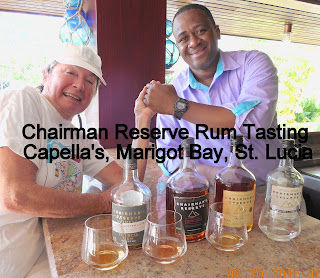
"All our plans are written in sand at low tide".
Cat Tales
First, get your facts, then you can distort them at your leisure.
Catherine & Peter
posted from Miami, FL
Catherine & Peter
posted from Miami, FL





















